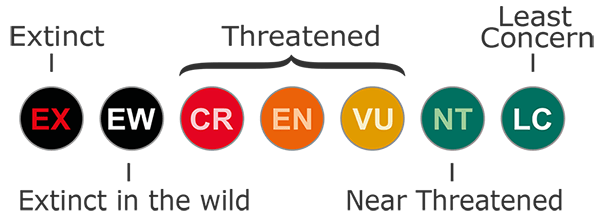People ask ‘Why are Pallas’s cats endangered?’ but they aren’t according to the people who are meant to know. It is a slightly surprising conclusion by the IUCN Red List people who’ve listed the Pallas’s cat as Least Concern. This is one step better than Near Threatened (see categories below). In other words, they believe that this small, attractive wild cat species is not threatened with extinction currently in 2023.


Their assessment is dated 6 November 2019 which is a little old. The species is possibly extinct in Armenia and Azerbaijan and possibly present (extant) in Uzbekistan and Tajikistan.
The listing of Least Concern is probably due to the fact that this species has a wide distribution. This helps to maintain its status despite a number of threats, the usual ones concerned with human activity such as residential and commercial development, agriculture and aquaculture, mining and energy production, transportation and the building of roads, hunting and trapping for their fur and so on.
Specifically, the experts say that they are difficult to protect in reserves because they have large home ranges. They are dependent upon shelters made by other threatened species such as Siberian marmots.
Their distribution is fragmented. They use marmot burrows to seek refuge from predators. Because the marmot population is declining due to its overharvesting by humans and is now classified as endangered, the argument is that there are less marmot burrows for Pallas’s cats to hide in.
Habitat degradation is the most serious threat which is due to increased livestock in the areas where they live. This includes conversion of grasslands into arable land and infrastructure development combined with resource extraction including mineral exploitation and infrastructure developments. These all combine to degrade the quiet enjoyment of the habitat of this small cat species.
In Mongolia, livestock numbers have increased from 26 million in 1991 to 66 million in 2018 according to the National Statistical Office of Mongolia.
Livestock damages their habitat and displaces the Pallas’s cat.
There is also predation by feral and herding dogs. Sometimes there is accidental capture through trapping or snaring. There is also illegal hunting of the species.
Climate change has had a negative impact on Pallas’s cat. It is having a detrimental impact on the grasslands and mountain ecosystems of central Asia and the Himalayas.
The experts expect a cascade of changes to the ecosystems in these areas. Pallas’s cat breeding is dictated by the length of the day and there are fears that the cat may be unable to respond to seasonal changes due to climate change.
Pallas’s cats build up fat during the season when prey is abundant and burn their fat when prey availability is low. Climate change is predicted to alter seasonal patterns and prey availability which may affect their ability to control energy reserves as described.
There is poisoning of small mammals such as pikas to try and reduce disease transmission from these animals to humans and livestock. Pikas are a prey animal of the Pallas’s cat.
In China pika numbers have been reduced by 95% and $35.5 million was spent between 2006 and 2013 to eradicate the plateau pika in Sanjiangyuan National Nature Reserve.
There will also be secondary poison if such large numbers of small prey animals are poisoned by the authorities. There seems to be a disregard for Pallas’s cat in this respect. How are the authorities prioritising animal species? Is this speciesism?
Note: Pallas’s cat is sometimes referred to as ‘Pallas cat’ and the proper name is ‘manul’.
Below are a couple more pages on Pallas’s cat but there are many more on this website so please search for them if it interests you.
Pallas’s cat lives at the highest point above sea level of all the cat species

